- By Richard Meagher
- Business & Technology
 Print
Print 1. Is your computer a desktop or a laptop?
2. Is your system Windows or Apple?
3. Does your system have USB ports?
4. Do you know how to open a computer and install PCI cards?
Let’s take a look at the different network interface components styles available:
These adapters are inserted into a PCI slot on your system’s motherboard. Unless you know how to install and remove devices from inside your computer, it is recommended that you have a professional install and configure these types of network cards. Otherwise, check out the USB adapters below. PCI cards use less system resources (memory and processing speed) than USB devices (see below).
 | 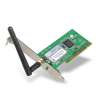 |
| PCI Interface card (Linksys) | PCI Interface card (Belkin) |
USB 2.0 Desktop Adapters
These adapters can easily be set up without dismantling your system. Just plug the USB cable into one of the available USB slots in the back of your PC or laptop. Load the software and follow the instructions provided. A word of caution here is that the wireless 802.11g adapters require USB 2.0 ports. If you have an older system, it likely has a USB 1.1 port which may only work with slower 802.11b devices. One advantage to these types of USB devices is that the antenna can be positioned away from interfering signals around the PC.
 | 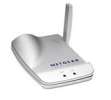 |
| USB desktop adapter (Linksys) | USB desktop adapter (Belkin) |
USB 2.0 Pocket Adapters
These adapters are ideal for traveling or situations requiring mobility. Easily set up without dismantling your system. Just plug the USB plug into one of the available USB slots in the back of your PC or laptop. A word of caution here is that wireless 802.11g adapters require USB 2.0 ports. If you have an older system, it likely has a USB 1.1 port which may only work with slower 802.11b devices.
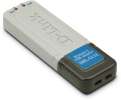 | 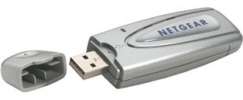 |
| Pocket sized USB Adapter (Linksys) | Pocket sized USB Adapter (Belkin) |
PCMCIA Cards
Stands for Personal Computer Memory Card International Association, PCMCIA cards are designed for portable or laptop computers. The cards fit in card sized laptop slots. They are less prone to being accidentally knocked off since the cards are almost completely inserted into the laptop slot leaving only the antenna portion exposed. USB cards stick out more, but that can be an advantage if you need better reception.
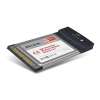 | 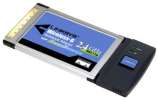 |
| PCMCIA Adapter (Linksys) | PCMCIA Adapter (Belkin) |
Apple iMac (Desktops)
Apple iMac computers running the latest Mac OS X operating system can connect to any wireless network, but configuring a non-Apple interface adaptor to work can test your patience. If you want to be up and running with your iMac, the Airport Extreme (802.11g compliant) is the way to go. However, it does require installation inside your Mac which is not as difficult as installing the PCI card in your Windows PC.
 |
| Airport Extreme (Apple) |
With a wireless router and network interface cards covered, the next step is to plan your home network. The internet is an endless resource for learning about how to create your own wireless network. The best place to start with your research and learning more about home wireless networking is to visit the websites of the wireless device manufacturers, some of whose products are displayed above.
Three of them, Linksys (www.linksys.com), Belkin (www.belkin.com) and Netgear (www.netgear.com), provide easy-to-follow tutorials and illustrated guides. Some have wizards that ask questions about your current PC and network configuration and provide recommended hardware information based on your input.
Getting Connected
Let’s assume that you have no wired or wireless home network, just the basic cable modem and PC network like the illustration below:
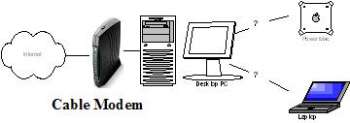
In the scenario above, you may also have one or more computers you would like to connect. A wireless home network makes it much easier to add or connect PCs. A recommended configuration is to set up a base station using your primary machine connected to the new router with a cable. Since you will need to install software and perform some periodic upgrades to the router firmware, it is recommended that the computer use a wired connection to the router. Once that is set-up, all that is left to do is add the interface adapters to the other PCs and you now have a wireless network.
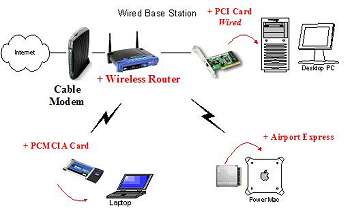
If you are still the victim of an extreme makeover and your lone PC is too far to connect to the modem and router without unsightly cables running around, fret not. You can temporarily use the base station method to get your software installed and then disconnect the cable after you install and configured either a wireless PCI card or USB adapter into your PC. You can still add more PCs to the network in the future now that you have your basic wireless network setup like the following diagram:
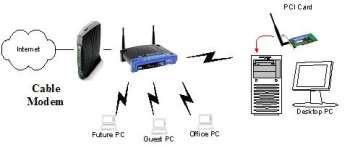
Some Assembly Required
Although not necessary, I prefer to buy everything from the same manufacturer. If you get a Linksys router, then buy a Linksys wireless card or adapter. Same thing for Net Gear, Belkin and D-Link. This makes it easier to find get support online and to follow directions on how to hook-up and configure everything, especially if it is your first time doing it.
When you have finally selected and purchased the devices, it is very important to follow the directions for your system before setting everything up. Do not connect anything until you have read the instructions first. Sometimes you may need to install the software before doing anything and sometimes not. You may still need to have your system connected to the internet to download any upgrades or obtain more information before tearing everything apart. Another important advice here is making sure everything is unplugged or powered off. The PCs can be plugged in, but must be turned off. Do not plug anything or power on the PCs until everything is connected.
Once you have connected everything, follow instructions on how to power everything on. The sequence of powering up the devices on your network is very important. It is usually the cable modem first, wait a couple of minutes, then the router and then the PCs. Always follow this sequence whenever you disconnect the power to any wireless network device. Turning off the PCs won’t affect the network as they are the last ones to be turned on. It is ok to turn them off when not in use.
Selecting, buying and setting up a wireless network is not all that difficult as long as you take the time to do a little research, visit the websites of the manufacturers and follow the manufacturers’ directions. I have found the support and help from the websites to be very good and you can get answers to questions quickly. Sometimes you may need to be patient. Another thing I discovered is that when something isn’t working right, disconnect everything and start all over. It is better than cursing in seven languages all night, lose sleep and be a real pain at work or to your family in the morning.
Once you are able to connect to the internet from your laptop in the next room, now you need to spend time with your family and come back next time to read about how your wireless network is actually open to unwanted visitors. I will discuss some things that you should know about keeping your network and your computers safe and hidden from outside hackers.
----
v1i17




